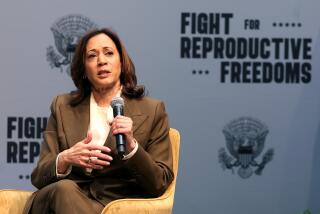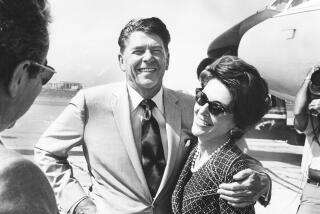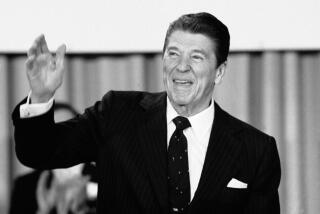Reagan Tamed a Rough Right
When Ronald Reagan emerged on the California political scene in the mid-1960s, the conservative movement was a collection of ineffective, naysaying right-wingers huddling in Orange County and San Gabriel Valley backyards, feverishly parsing school books for signs of communist or pornographic influence and flirting with the oddball extremists of the John Birch Society.
Reagan taught manners to these misfits and, in the process, gave them respectability. He shared their intense patriotism, their economic and social conservatism and their militant anti-communism, but he was likable, more genial than fierce.
Most important, Reagan understood that a successful political movement had to be inclusive. Ironclad adherence to right-wing philosophy would not win the votes of moderate Republicans or of the growing number of Democrats disenchanted with their party’s support of strong civil rights laws and its soft attitude toward student demonstrations.
Charmed by his personality, enthralled by his speeches and celebrity and wowed by his political skills, California conservatives lined up behind him enthusiastically, as did conservatives around the nation in the years that followed. They became an essential part of what he called “a prairie fire,” sweeping through the growing suburbs of the West and the South and ultimately into the once reliably Democratic working-class neighborhoods of the Midwest and East.
The combination carried him from speechmaker in Barry Goldwater’s 1964 presidential campaign to two terms as governor, beginning in 1967.
As a reporter for the Associated Press in Sacramento and later as a political reporter for The Times, it was clear to me from the start that Reagan brought life experiences to politics that the ideological right-wingers who had previously dominated the movement simply didn’t have. That enabled him to make friends across the spectrum and to smooth over the rough edges that had previously characterized the state’s conservative movement.
The incident that I remember most fondly occurred in 1969 when the wire service branch of the American Newspaper Guild went on strike against the AP. The Sacramento bureau, where I worked, was in the Capitol, and we wanted to put a picket line out in front of our office. But there had never been a picket line inside the Capitol. We needed support and we knew the man who could help us -- the conservative governor, Ronald Reagan, who despite his pro-business policies was, nevertheless, a former president of the Screen Actors Guild and the leader of a SAG strike in 1959.
We asked his press secretary, Paul Beck, to find out whether the governor would support us, and not long afterward, we received the go-ahead. With our picket signs sanctioned by the governor, we walked in front of the AP office during the few days of the strike.
It didn’t mean Reagan was a union lover; we all know that later, as president, he fired more than 11,000 striking air traffic controllers. But I can’t help but believe that on a personal level, he retained a certain openness or at least sympathy for some of us working stiffs.
A far more significant example of Reagan’s view of life occurred in 1978 after he left Sacramento and was preparing to run for president. John Briggs, a right-wing state senator, was winning great support throughout California for an initiative that would have removed gay teachers from classrooms. The anti-gay movement, then starring singer Anita Bryant, was strong nationally and hard to ignore in Republican circles.
The anti-Briggs forces badly needed to win a prominent conservative supporter to their side and, against all odds, hoped it would be Reagan. They felt that the witch-hunting aspects of the initiative would offend his respect for legal institutions, and they were aware that he and his wife, Nancy, had long associated with gays in their years in Hollywood-- but they worried that it would be a difficult political position for a conservative leader hoping to run for president to take.
Reagan met with initiative opponents, studied their material and, ultimately, at the risk of offending his anti-gay supporters in the coming presidential election, wrote in his newspaper column: “I don’t approve of teaching a so-called gay life style in our schools, but there is already adequate legal machinery to deal with such problems if and when they arise.”
His opposition turned public opinion around, and the measure lost with 42% of the vote.
Reagan was a conservative, but more than that he was a practical man. He understood that politics were not just about ideology, but about people and relationships. He demonstrated that with people as varied as Tip O’Neill, with whom he had an instant rapport, and Mikhail Gorbachev, with whom he oversaw the beginning of the end of the Cold War, and with a handful of ragtag strikers in the Capitol building in Sacramento.
That’s why on election night in 1980, when Reagan was voted into office, the United States was not a divided, polarized, 50-50 nation, as it was in 2000. Reagan beat President Jimmy Carter handily and steamrollered Walter Mondale four years later with votes from a wide and disparate cross section of America. And although Democrats mourned the losses, Reagan’s victories did not leave the nation bitter and resentful, as it is today.
*
Bill Boyarsky, a former Times editor and reporter, is author of two biographies of Ronald Reagan and is writing a biography of Jesse M. Unruh.
More to Read
Get the L.A. Times Politics newsletter
Deeply reported insights into legislation, politics and policy from Sacramento, Washington and beyond. In your inbox three times per week.
You may occasionally receive promotional content from the Los Angeles Times.










